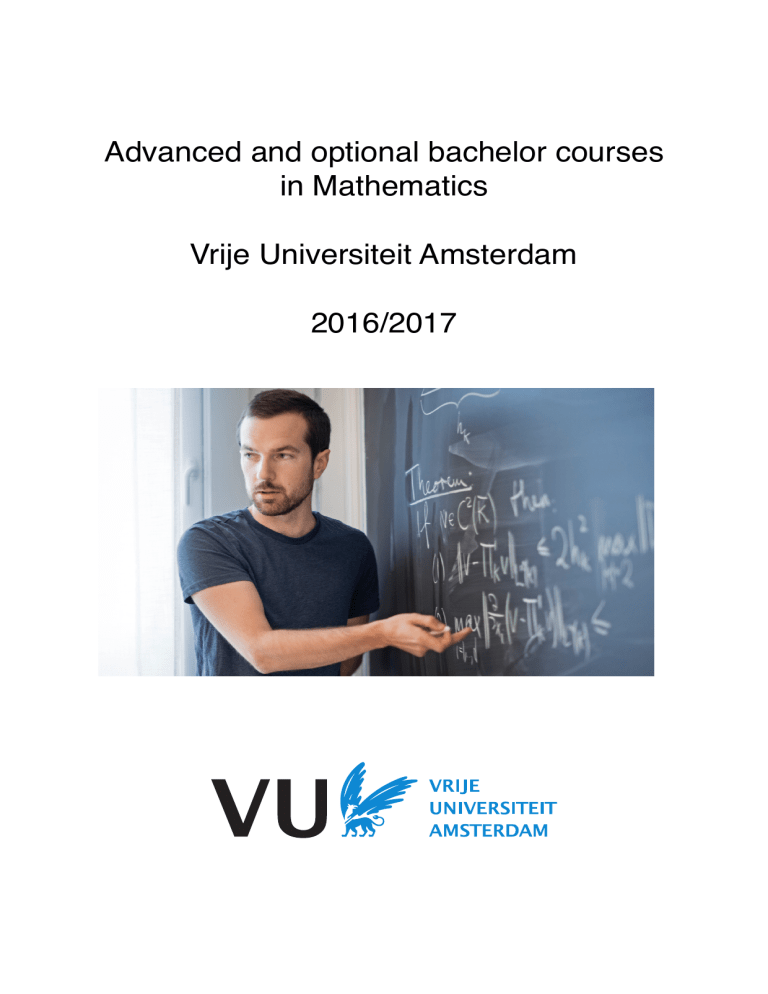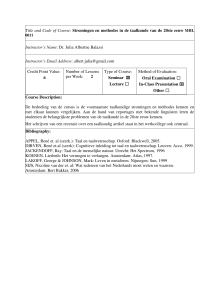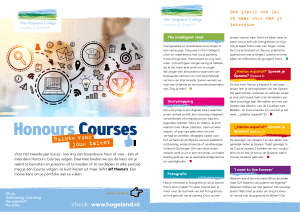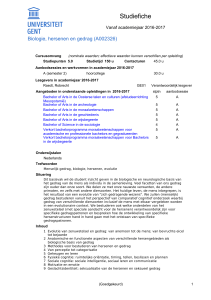
Advanced and optional bachelor courses
in Mathematics
Vrije Universiteit Amsterdam
2016/2017
Dear Student
Mathematics stretches from the purely fundamental to the directly applicable, but
it also entangles these extremes. It can be challenging to choose your favourite
courses. In this booklet we give an overview of advanced bachelor courses in
mathematics offered by the Department of Mathematics of the Vrije Universiteit
Amsterdam, as well as by our partner, the University of Amsterdam. We hope it
will help you making informed choices about the courses you decide to follow.
No attempt was made to duplicate all information from the study-guide (you
should consult www.studiegids.vu.nl and www.studiegids.uva.nl for additional
details). We also advise that you discuss your options with the study advisor as
early as possible. For and overview of Master courses in Mathematics, we refer to
the “MSc Mathematics and SFM Manual”.
The Bachelor courses of the first semester are listed in alphabetic order, followed
by the courses of the second semester. The language of instruction is usually
flexibly adjusted to the audience.
Enjoy the many opportunities that mathematics has to offer!
Course
Applied Analysis: Financial Mathematics
Lecturer
.
André Ran
Description
Financial mathematics is an exciting piece of mathematics for two
reasons. The first is that it is an interesting and relevant application of
advanced mathematics. The second reason is that it presents a field
where divers parts of mathematics come together in the context of one
application: in the course one needs parts of probability theory and
stochastic calculus, parts of ordinary and partial differential equations,
and parts of numerical analysis.
This course gives an introduction to financial mathematics. The
following subjects will be treated: introduction in the theory of options
via the binomial model, modeling of option prices using stochastic
differential equations and the Black-Scholes analysis, discussion of
some elementary theory of partial differential equations, in particular
the heat equation, solutions of the Black-Scholes equation, and an
introduction to numerical methods for the approximation of the price of
an (American) option.
Area / Keywords
Analysis, Financial Math
Location
Period
VU
1,2
Level
Bachelor
Language
EC
English
6
:
1
Course
Complex Dynamical Systems
Lecturer
.
Han Peters
Description
Complexe dynamica kwam in het begin van de twintigste eeuw tot
bloei door bijdragen van Julia en (vooral) Fatou. Daarna werd het
grotendeels vergeten tot het veertig jaar later opnieuw tot bloei kwam
door onder anderen Hubbard, Douady en Sullivan. Prachtige
computersimulaties maakten in die jaren de Mandelbrot- en
Juliaverzamelingen tot algemeen bekende termen. In dit vak bekijken
we vooral de theorie die in het begin van de twintigste eeuw werd
ontwikkeld door Fatou. We bestuderen iteratie van polynomen en
rationale functies op de Riemann-sfeer. Einddoelen zijn de classificatie
van Fatou componenten en de zelfgelijkvormigheidheid van Julia
verzamelingen.
Area / Keywords
Analysis
Location
Period
UvA
1,2
Level
Bachelor
Language
EC
Dutch
6
:
2
Course
Differential Geometry
Lecturer
.
Oliver Fabert
Description
This course is an introduction to the theory of manifolds. These may be
interpreted as generalisations of curves and surfaces to arbitrary
dimensions. Apart from giving the relevant definitions from differential
topology (manifolds, vector bundles and differential forms), we make
short excursions to Riemannian geometry (Riemannian metric) as well
as to algebraic topology (fundamental group and de Rham
cohomology). More precisely, the subject list includes:
- Definition of smooth manifolds
- Submanifolds, immersions
- Constant rank maps
- Vector bundles and bundle maps
- Tangent bundle, cotangent bundle, normal bundle
- Differential forms
- Riemannian metric, distances on Riemannian manifolds
- Stokes’ Theorem
- De Rham cohomology
- Mayer-Vietoris theorem
- Computation of cohomology groups
Area / Keywords
Analysis, Geometry
Location
Period
VU
1,2
Level
Bachelor
Language
EC
English
6
:
3
Course
Measure Theory
Lecturer
.
Ronald Meester
Description
We motivate and introduce the notion of a measure, that is, a way to
assign a size to as many subsets as possible in an abstract space. It
turns out that it is in general not possible to measure all sets, at least if
one insists on additivity of the measure. This leads to the notion of a
sigma-algebra.
Once we have defined measure, we can introduce and discuss so
called measurable functions which, roughly speaking, form the class of
functions which we will be able to integrate. We then introduce and
study integration of these measurable functions with respect to a
measure. We discuss (among other things) the monotone and
dominated convergence theorems concerning the interchangeability of
limit and integral, the substitution rule, absolute continuity and the
relation of this new integral to the Riemann integral. We also discuss
multi-dimensional Lebesgue measure, product measures and Fubini's
theorem. The theory leads to a new perspective on integration of
functions, which is not only more general when working on the real
line, but also allows one to work in an abstract setting. This is of crucial
importance for the development of (for example) functional analysis
and probability theory.
Area / Keywords
Lebesgue measure,
Integration, Analysis
Location
Period
VU
1,2
Level
Bachelor
Language
EC
English
6
:
4
Course
Number Theory
Lecturer
.
Sander Dahmen
Description
Doel van dit vak is het leren van elementaire begrippen en technieken
uit de getaltheorie en deze kunnen toepassen op concrete problemen.
Ook een aantal moderne ontwikkelingen en open problemen in de
getaltheorie zullen besproken worden. Naast een theoretische
benadering zullen ook praktische/algoritmische aspecten aan bod
komen. In het bijzonder zal geleerd worden hoe het wiskunde
softwaresysteem "Sage" gebruikt kan worden voor het expliciet
uitvoeren van getaltheoretische berekeningen.
De volgende onderwerpen worden behandeld:
- Gehele getallen, deelbaarheid, ggd
- Priemgetallen, factorisatie, priemverdeling
- Congruenties, primitieve wortels
- Aritmetische functies
- Publieke sleutel cryptografie
- Kwadratische reciprociteit
- Sommen van kwadraten
- Kettingbreuken
- Diophantische vergelijkingen, abc-vermoeden
- Irrationaliteit, transcendentie (bij voldoende tijd)
Area / Keywords
Algebra
Location
Period
VU
1,2
Level
Bachelor
Language
EC
Dutch
6
:
5
Course
Probability Theory: Markov Chains
Lecturer
.
Sindo Nunez-Queija
Description
Het college bestaat uit drie delen. In het eerste (en grootste) deel
worden Markov ketens in discrete tijd geïntroduceerd. De volgende
begrippen zullen worden behandeld: klassen structuur van toestanden,
intreetijden, absorptie kansen, sterke Markov eigenschap, random
walks, evenwichtsverdelingen, convergentie naar evenwicht en
omkeerbaarheid (reversibility).
Het tweede deel betreft continue-tijds Markov ketens. Veel aandacht
zal hierbij worden besteed aan de exponentiële verdeling, het Poisson
proces en ingebedde discrete-tijds Markov ketens.
Het laatste deel (3 weken) betreft toepassingen van Markov ketens,
met bijzondere aandacht voor vertakkingsprocessen en
wachtrijtheorie.
Area / Keywords
Stochastics, Probability
Location
Period
UvA
1,2
Level
Bachelor
Language
EC
Dutch
6
:
6
Course
Representation Theory
Lecturer
.
Eric Opdam
Description
In een eerder Algebra college hebben we kennisgemaakt met de
groepentheorie. In de representatietheorie kijken we naar de situatie
van een groep G die werkt door lineaire transformaties op een
vectorruimte V; anders gezegd, we hebben een homomorfisme
G➞GL(V). Dit is een situatie die we overal in de wiskunde
tegenkomen. Qua moeilijkheidsgraad loopt de representatietheorie van
vrij elementair (dit vak) tot aan de grenzen van onze kennis. We zullen
ons in hoofdzaak richten op de theorie voor eindige groepen, maar
onderweg komen we veel begrippen en technieken tegen die in een
veel bredere context van belang zijn; daardoor vormt dit vak een goede
opstap naar de representatietheorie van Liegroepen of algebraïsche
groepen. Naast de abstracte theorie zullen we uitvoerig ingaan op
concrete voorbeelden, zoals de representatietheorie van
permutatiegroepen.
Area / Keywords
Algebra
Location
Period
UvA
1,2
Level
Bachelor
Language
EC
Dutch
6
:
7
Course
Workshop Mathematical Modelling
Lecturer
.
Bob Planqué, Mark van de Wiel
Description
In this workshop we adapt the format of the annual Studygroups
Mathematics & Industry, smeered out over four weeks rather than one.
Thus we invite people working in industry to present problems that
need a mathematical formulation and subsequent treatment. Students
then work in groups on different problems from different companies,
or on different aspects of the same problem, the goal being to solve the
problems presented. In the last week the participants write a report and
give a presentation.
..
:
Area / Keywords
Analysis, Probability,
Statistics, Applications
Location
Period
VU
3
Level
Bachelor
Language
EC
English
6
8
Course
Algebraic Topology
Lecturer
.
Dietrich Notbohm
Description
If you have a dog which is completely covered in hair, then there is no
way of combing that hair smooth, so that there is no parting or bald
spot. This is the so-called `hairy dog theorem'. Fact: no matter how
badly you make a sandwich out of two pieces of bread and a slice of
ham, it is always possible to find a plane cutting the sandwich which
bisects exactly each piece of bread and the slice of meat. This is the
so-called `ham-sandwich theorem'. Fact: if you associate to each point
of the Earth's surface the two numbers t and p given by temperature
and air pressure at this point, then there is always at least one point
which has the same values for t and p as its diametrically opposite one.
This is the so-called `Borsuk-Ulam theorem'. These are all very deep
geometric facts about the shapes of dogs, ham sandwiches and the
Earth; they are especially deep as they are true for any shape or size of
dog, sandwich or planet, and they are all proven by a remarkably
successful set of mathematical ideas and methods that date from the
early mid of last century. These ideas and ones like them constitute the
subject Algebraic Topology. The basic idea of the subject is to find a
formal way to translate geometric problems into an appropriate
algebraic language. If this is done successfully, then the geometric
problem is usually reduced to a fairly simple piece of algebra and can
be solved by algebraic means. In this course we provide the technical
tools (fundamental group, homology groups of topological spaces) and
shall prove each of the facts above by translating the underlying
geometry into questions about integers, groups or vector spaces.
Area / Keywords
Topology, Geometry,
Analysis
Location
Period
VU
4,5
Level
Bachelor
Language
EC
English
6
:
9
Course
Bayesian Statistics
Lecturer
.
Bas Kleijn
Description
Frequentistische statistiek is gebaseerd op de veronderstelling dat de
data verdeeld is volgens een onbekende distributie. Bayesiaanse
statistiek gaat uit van een ander beginsel, waarin data en parameter op
gelijke voet behandeld worden. De Bayesiaanse procedure vereist
naast specificatie van het model ook keuze van een zogeheten prior
verdeling over het model. De data wordt ingezet om de prior om te
zetten in de zogenaamde posterior verdeling. In dit vak kijken we naar
enkele gangbare statistische vragen, zoals schatting van de model
parameter, toetsing van hypotheses, constructie van
betrouwbaarheidsintervallen en het opstellen van beslisfuncties,
waarin telkens frequentistische en Bayesiaanse methoden worden
beschreven en vergeleken. Voorts wordt ruim aandacht geschonken
aan de keuze voor de prior, die afhangt van zowel het statistisch model
in kwestie, als het beoogde doel van de posterior. Dit vak gaat niet in
op computationele aspecten, noch op niet-parametrische en
asymptotische eigenschappen van de posterior.
Area / Keywords
Stochastics, Statistics
Location
Period
UvA
4,5
Level
Bachelor
Language
EC
Dutch
6
:
10
Course
Biomedische Wiskunde
Lecturer
.
Bob Planqué, Wessel van Wieringen
Description
Dit vak bestaat uit twee delen.
1. De wiskunde die gebruikt wordt in de biomedische hoek is een
minder overzichtelijk bouwwerk dan in veel andere disciplines. Een
goed overzicht van de meestgebruikte methoden, hun aannames,
sterke en zwakke punten, is dan ook het voornaamste doel van dit vak.
We behandelen aan de hand van het boek een aantal van de
bekendste modellen die gebruikt wordt bij verscheidene biologische
toepassingen, zoals populatiedynamica, besmettelijke ziekten,
populatiegenetica, en moleculaire biologie. De wiskunde beperkt zich
hoofdzakelijk tot gewone differentiaalvergelijkingen, maar we zullen
ook andere technieken behandelen, zoals Leslie matrices, speltheorie
en discrete dynamische systemen.
2. In het eerste deel van het college staat het modelleren van de DNA
sequentie centraal. Resulterende modellen worden aangewend om de
exon-intron structuur van een gen te ontrafelen. Maar ook om de
evolutie van het DNA te beschrijven, en phylogenetische bomen
(afstammingsbomen) te reconstrueren. In het tweede deel wordt
hoogdimensionaliteit geïntroduceerd, i.e., een klein aantal samples
waarvan een groot aantal eigenschappen gemeten is. Dit gooit het
traditionele paradigma van de statistiek op z'n kop. We zullen laten zijn
hoe met hoog-dimensionaliteit wordt omgegaan ten einde m.b.v. een
zo simpel mogelijk model een phenotype te voorspellen. Alsook hoe
de topologie van een biologisch pathway achterhaald kan worden.
..
:
Area / Keywords
Differential Equations,
Statistics, Applications
Location
Period
VU
4,5
Level
Bachelor
Language
EC
Dutch
6
11
Course
Forensic Statistics
Lecturer
.
Ronald Meester, Marjan Sjerps, Klaas Slooten
Description
Forensisch wetenschappers passen exacte wetenschap toe op sporen
die door de politie worden verzameld op de plaats van een misdrijf. Het
is een breed vakgebied waarbij de sporen variëren van schoenspoor
en DNA-profiel tot digitale sporen, en de misdrijven van diefstal en
fraude tot terroristische aanslagen. Uiteindelijk levert de
wetenschapper een rapport waarin hij de bewijskracht van zijn
onderzoeksresultaten moet aangeven. Dit college gaat over die
bewijskracht. Hoe is deze gedefinieerd, hoe wordt zij bepaald en
gecommuniceerd, en hoe kan zij worden gecombineerd met het
overige bewijs in de zaak? Het college zal worden geïllustreerd met
voorbeelden van strafzaken.
Aan de orde komen o.a.: verschillende kansbegrippen en stromingen
in de statistiek, de Likelihood Ratio als maat voor bewijskracht, voor
discrete en continue, univariate en multivariate data, enkelvoudige en
samengestelde hypothesen, speciale problemen (zoals database
zoekacties, selectie anderszins, ankering en eilandprobleem),
Bayesiaanse netwerken, forensische DNA statistiek, chemical
profiling, validatie.
Area / Keywords
Level
Statistics, Applications
Bachelor
Location
Period
Language
EC
UvA/VU
4,5
Dutch
6
..
...
:
12
Course
Functional Analysis
Lecturer
.
Bas Kleijn
Description
Dit vak is een inleiding tot de functionaalanalyse en Fourieranalyse.
Het is een belangrijk basisvak voor analyse, differentiaalvergelijkingen
en stochastiek.
Aan bod komen: genormeerde lineaire ruimtes; Hilbert-ruimtes;
Fourier-reeksen (L²-theorie); Begrensde lineaire operatoren; Stellingen
van Banach-Steinhaus, open afbeelding en gesloten grafiek; Fourierreeksen (convergentie en toepassingen); Stelling van Hahn-Banach en
dualiteit; spectraaltheorie.
Area / Keywords
Analysis, Stochastics,
Differential Equations
Location
Period
UvA
4,5
Level
Bachelor
Language
EC
Dutch
6
:
13
Course
Galois Theory
Lecturer
.
Gerard van der Geer
Description
De Galoistheorie is een van de centrale onderdelen van de wiskunde
en bestudeert de symmetrieen van lichamen en ook van de wortels van
algebraische vergelijkingen. Met behulp van de Galoistheorie kunnen
een aantal klassieke problemen in de wiskunde worden opgelost. We
behandelen de elementaire Galoistheorie en laten zien hoe genoemde
klassieke problemen worden opgelost.
Area / Keywords
Algebra
Location
Period
UvA
4,5
Level
Bachelor
Language
EC
Dutch
6
:
14
Course
Partial Differential Equations
Lecturer
.
Joost Hulshof
Description
The majority of physical phenomena can be described by partial
differential equations. This module discusses these equations and
methods for their solution. In particular, use is made of the remarkable
result of Fourier that almost any periodic function (i.e. one whose graph
endlessly repeats the same pattern) can be represented as a sum of
sines and cosines, called its Fourier series. An analogous
representation holds for al large class of functions defined on bounded
domains, using the eigenfunctions of suitable boundary value
problems.
Area / Keywords
Analysis, Differential
Equations
Location
Period
VU
4,5
Level
Bachelor
Language
EC
Dutch
6
:
15
Course
Statistical Data Analysis
Lecturer
.
Bartek Knapik
Description
The course introduces the students to several widely used statistical
models and methods, and the students are taught how to apply these
tools to real data while using the statistical software package R.
The following subjects are covered:
summarizing data;
investigating the distribution of data;
robust methods;
non-parametric methods;
bootstrap;
two-sample problems;
contingency tables;
multiple linear regression.
Area / Keywords
Statistics, Applications
Location
Period
VU
4,5
Level
Bachelor
Language
EC
English
6
:
16











